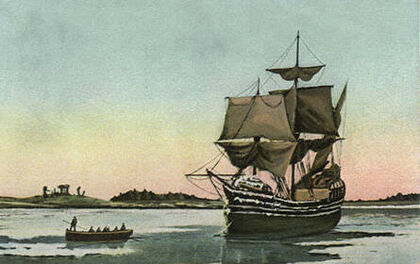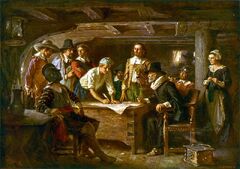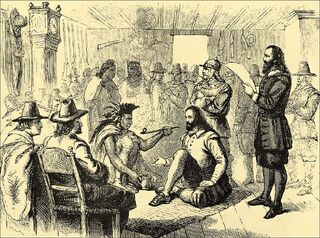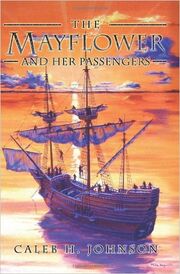
Mayflower at Provincetown Harbor
Landing of the Mayflower - People and events
Background[]
The miseries suffered by pilgrims in that first year at Plymouth Colony were not due to any inhospitable climate, but for the lateness of the year in which they landed as well as insufficiently planning their provisions. Of the 102 passengers many died during the harsh winter of 1620/21. When the next ship, Fortune, arrived in Nov 1621, only 52 settlers were left at Plymouth Rock. The nearby Wampanoags Indians taught the pilgrims how to plant corn for survival.
During the first winter in the New World, the Mayflower colonists suffered greatly from diseases like scurvy, lack of shelter and general conditions onboard ship. 45 of the 102 emigrants died the first winter and were buried on Cole's Hill. Additional deaths during the first year meant that only 53 people were alive in November 1621 to celebrate the first Thanksgiving. Of the 18 adult women, 13 died the first winter while another died in May. Only four adult women were left alive for the Thanksgiving.
- Landing of the Mayflower - Article
- Cole's Hill - memorial to those who died in the first winter.
- Mayflower - List of Mayflower passengers
- National Monument to the Forefathers - list of Mayflower passengers at Plymouth, Massachusetts
- Mayflower Compact - list of signatories.
Arrival : Nov 1620[]
Mayflower Compact[]

Signing the Mayflower Compact 1620, a painting by Jean Leon Gerome Ferris 1899
11 Nov 1620: After arriving and anchoring of the tip of Cape Cod at Provincetown Harbor, the first thing accomplished was the signing of the Mayflower Compact.
The Mayflower Compact was the first governing document of Plymouth Colony. It was written by the male passengers of the Mayflower, consisting of separatist Congregationalists who called themselves "Saints", and adventurers and tradesmen, most of whom were referred to by the Separatists as "Strangers". Later both groups were referred to as Pilgrims or Pilgrim Fathers. The Separatists were fleeing from religious persecution by King James of England (1566-1625).
The Mayflower Compact was signed aboard ship on November 11, 1620 by the Pilgrims (21-Nov-1620 on the modern Gregorian Calendar). They used the Julian Calendar, also known as Old Style dates, which, at that time, was ten days behind the Gregorian Calendar. Signing the covenant were 41 of the ship's 101 passengers, while the Mayflower was anchored in what is now Provincetown Harbor within the hook at the northern tip of Cape Cod.
1st Landing[]
11 Nov 1620: later that same morning, immediately after signing the compact, the Pilgrims made their first landing ashore with 15-16 men, "well armed, with some to fetch wood."
On 13 Nov, they brought their shallop ashore to begin reassembling it, and the women came ashore to do some laundry.
On 15 Nov, sixteen men were set out with every man his musket, sword and corselet, under the command of Captain Myles Standish (military expedition commander of the Pilgrims.) Along with them came William Bradford (1590-1657), Stephen Hopkins (1581-1644), and Edward Tilley (c1588-1621).
"Shortly into their walk up the Cape Cod coastline, from modern-day Provincetown toward Truro, the men saw "five or six people with a dog coming towards them," and quickly determined they were Indians. The Indians, seeing the armed Englishmen, ran into the forest. The Pilgrims followed their footsteps for about ten miles before nightfall, but could never meet up with them. The next day, they went in search of the Indians, and in search of fresh water (strangely, they had failed to bring any water with them!). They happen upon fresh water aboutmidday, and "sat us down and drunk our first New England water with as much delight as ever we drunk drink in all our lives".
After finding water, they explored the area of the Pamet River (in modern-day Truro MA), finding an old Indian house, and dug up a baseket full of thirty-six ears of corn that had been buried, "some yellow, and some red, and others mixed with blue." which they took. They found other mounds which they dug up hoping to find more food, but most only turned out to be graves.
2nd Trip to Pamet River[]
The next exploration group was much larger, 34 men, using both the ship's shallop and longboat. While technically led by the Mayflower's master Christopher Jones (c1570-1622), Myles Standish remained a major influence.
They returned to the Pamet River area, which they named Cold Harbor, and explored up both creeks. Finding little they returned to "Corn Hill" and dug up more mounds from which they got more corn seed. That night about half of the weakest people in the group returned to the Mayflower with Master Jones. That left about 18 men to continue exploring with Capt Standish.
The next day they encountered a much larger grave which they dug up, finding mats, trays, bows and arrows, red powder and "the bones and skull of a man" with "fine yellow hair still on it". Along this skeleton of a European sailor they found a sailor's canvas cassock, a pair of breeches, knife, and other things ordinary to a European sailer. They returned to the Mayflower, still not having found a suitable place to build a village.
Expedition #3[]
06 Dec 1620: The third major expedition set out on 6 Dec 1620 with eighteen men under Capt Standish. The sailed first to what is now Welfleet Harbor where they spied several Indians cleaning a large fish on the shoreline, but the tide prevented them form getting closer.
The next night this group lodged near what is now Eastham MA. In the middle of the night they heard some strange howls, which some thought were wolves. They heard them again about 5AM, but this time it was an attack by Nauset Indians and arrows began to fly in their direction. Capt Standish returned two shots to scare off the attackers. The pilgrims continued on their way.
08 Dec 1620: Later that day, first their rudder broke, than the mast broke into three pieces, forcing them to paddle and steer with a few oars. The following day was the Sabbath, for which they rested. On Monday they reached Plymouth Harbor and determined that to be the best place to settle.
The pilgrims began building houses here.
Expedition #4[]
22(?) Dec 1620: about two weeks into building their houses at Plymouth, Capt Standish led another expedition with five men to find any Indians, having seen none since the attack on the 8th. But none were found.
Winter Casualties[]
About a month into the building of houses started to see an uptick in casualties to famine.
From Bradford's journal:
"But that which was most sad, and lamentable, was that in 2 or 3 months' time half of their company died, especially in January and Fegruary, being the depth of winter...so as there died sometimes 2 or 3 of a day, in the aforesaid time, that of 100 and odd persons scarce fifty remained: and of these in the time of most distress there was but 6 ot 7 sound persons; who to their great commendations, be it spoken, spared no pains, night nor day, but with abundance of toil and hazard of their own health, fetched them wood, made them fires, dressed them meat, made their beds, washed their loathsome clothes, clothed and unclothed them. In a word did all the homely and necessary offices for them, which dainty and queasy stomachs cannot endure to hear named; and all this willingly and cheerfully, without any grudging in the least, showing herein their true love unto their friends and brethren; a rare example and worthy to be remembered. two of these 7 were Mr. William Brewster their reverend Elder, and Myles Standish their captain and military commander (unto whom myself, and many others were much beholden in our low, and sick condition) and the yet the Lord so upheld these person, as in this general calamity they were not at all infected either with sickness or lameness."
Partial Casualty List:
- 29 Jan 1621 : Death of Rose Handley (c1585-1621), wife of Capt Standish.
Indian Meetings[]

Massasoit smoking a ceremonial pipe with Governor John Carver in Plymouth 1621.
Tribal Background[]
Samoset explained that this tribe of about 100 Indians, had been the ones to previously attack the Pilgrims. There hostility towards Europeans was a result of a earlier encounter with an English Captain, Thomas Hunt, who in 1614 had kidnapped several of their tribe and take then to Spain where they were sold as slaves. One of these captives was an indian named Squanto (c1585-1622) who had returned here a couple of years ago on a ship with Captain Thomas Dermer.
Outbreaks of smallpox had devastated the Pokanokets, and Massasoit (c1581-1661) sought an alliance with the English against the neighboring Narragansetts who controlled an area west of Narragansett Bay in present-day Rhode Island.
Missing Tools[]
16 Feb 1621: Myles Standish (c1584-1656) and Francis Cooke (1583-1663) were out cutting wood and gathering thatch for houses. Upon returning from a lunch break they found all their tools had been stolen by some Indians.
17 Feb 1621: The next day, the colonists met to formally elect Myles Standish (c1584-1656) as their captain, but the ceremony was interrupted when several Indians showed themselves at the top of a hill and gestured for them to come meet them. Capt Standish and Stephen Hopkins (1581-1644) approached them, laying down their muskets as sign of peace. But the Indians fled. There was a noise of many more nearby, but none showed themselves.
The Pilgrims decided it was best to bring ashore some cannon and other artillery to better defend their village.
Samoset[]
16(?) Mar 1621: About a month later, the Pilgrims resumed their ceremony to appoint Standish as Captain, but they were again interrupted when walked right into the ceremony, "where we intercepted him, not suffering him to go in, as undoubtedly he would out of his boldness." Then adding to their surprise, "he saluted us in English, and bade us welcome."
He indentified himself as Samoset (c1590-1653), a resident of Maine who had learned some English from the fishing vessels that traded there.
Samoset told them that their nearest neighbors were the tribe of Massosoit, about sixty strong. After that were the Nauset, about 100 strong, which had been the group to attack them earlier.
Nauset Tribe[]
Samoset explained that this tribe of about 100 Indians, had been the ones to previously attack the Pilgrims. There hostility towards Europeans was a result of a earlier encounter with an English Captain, Thomas Hunt, who in 1614 had kidnapped several of their tribe and take then to Spain where they were sold as slaves. One of these captives was an indian named Squanto (c1585-1622) who had returned here a couple of years ago on a ship with Captain Thomas Dermer.
Samoset promised to return soon with Squanto and others from both tribes to meet with the Pilgrims and to trade beaver skins.
Indian Peace Treaty[]
22 March 1621: The Pilgrims met again to appoint Standish as Captain and for the third time, Indians arrived, interrupting the ceremony. This time it was Samoset (c1590-1653), Squanto (c1585-1622), Massasoit (c1581-1661) and his brother Quadequina (c1582-).
Myles Standish (c1584-1656) and William Brewster (1567-1644) went out to meet them and escorted them to the house of Governor John Carver (1565-1621). There Carver and Massosoit formed a defensive alliance.
In an almost identical scenario as that of Thomas Dermer a year earlier, he and his brother along with 60 armed men came and stood at the top of the hill overlooking the Colony. Edward Winslow was sent to him with some knives and a copper jewel chain as gifts--and Massasoit was told that the Pilgrims only desired peace and trading. Massasoit was told that King James of England saluted him with love and peace, and accepted him as a friend and ally. Massasoit liked what he heard; the English would make powerful allies against his enemies in the region. The Pilgrims wanted a peace treaty, and so he willingly undertook the negotiations.
At the peace negotiation, he was met at the river by Captain Myles Standish and Elder William Brewster. They saluted one another and he was taken to William Bradford's house for the negotiations with Governor John Carver. Massasoit was given some liquor, fresh meat, and some biscuits. Massasoit and the Pilgrims agreed to a treaty which said that none of Massasoit's men would harm the Pilgrims--and if they did, he would send them to the Pilgrims for punishment. And if anyone did unjust war against Massasoit, the Pilgrims would come to his aid. They also agreed that when trading, the Indians would not bring their bows and arrows, and the Pilgrims would not bring their guns.
Visits to Pokanoket[]
After meeting in the Pilgrim village, Massasoit then invited a Pilgrim delegation to meet him at their place. Myles Standish (c1584-1656) and Isaac Allerton (1586-1658) volunteered for the adventure. Massasoit (c1581-1661) gave to them ground nuts and tobacco as gifts when they arrived, and Standish and Allerton presented him with a kettle of peas.
A second trip to Pokanoket, where Massasoit lived, was made by the Pilgrims, so that they could learn more about their neighbors and to make some additions to their treaty. This time, Edward Winslow (1595-1655) and Stephen Hopkins (1581-1644) were chosen to make the trip. Massasoit came out to see them when they arrived at the end of their several-days journey. They reaffirmed their peace with one another, and Massasoit agreed to tell his Indians to stop making random visits to Plymouth looking for food and entertainment; and he also agreed to send a messenger to contact the Indians of which the Pilgrims took corn from upon their first arrival--since they had thus far not been able to repay them.
1621[]
During the year a messenger arrived from the Narragansett tribe with a rattlesnake stuffed full of arrows, a message of hostile intent. This prompted the pilgrims to begin construction of a fort and walls to enclose their town. They also initiated a night watch.
1622[]
In July 1622, two ships with passengers, the Charity and the Swan. They were sent by Thomas Weston who had sold his shares in the Plymouth Company and formed a new company to settle Wesseagussett Colony nearby to the north in Massachusetts Bay. This group included many unsavory individuals who "borrowed" much from the Plymouth Colony foodstocks. That group ran out of food by Nov 1622 and started to steal food stuffs from the Indian.
They formed a joint trade expedition between the two groups to trade with the indians, but that mission was fraught with much tragedy, sickness, boat wreck and the death of their indian guide and interpreter Squanto (c1585-1622). Trade goods were stolen and relations with various local tribes deteriorated badly with even an attempt to assasinate Captain Standish.
Meanwhile, Edward Winslow (1595-1655) was called upon to help doctor a very sick Massasoit (c1581-1661), leader of the other indian tribe. After recovering quickly from a nearly fatal sickness, a grateful Massasoit told Winslow about the indian plot to destory the colonists and urged them to kill the rebel indian leaders.
A few days later one of the Wessagusset colonists, Phineas Pratt (1590-1680), came running all the way through the snow to Plymouth to tell about the terrible state of the colony there. He had also heard slip from an indian woman about the plot to destroy the English colonies.
Captain Standish was authorized to kill Wituwamat, leader of the rebel indian band. He went north (Feb/Mar 1623) to Wesseagusett and found conditions near starvation there. He advised all of those colonists to go to Maine and catch a ride home to England with any fishing vessels they might find there. His group then continued their hunt for the hostile indian group.
10 March 1623: They soon afterwards encountered the hostile indians and killed several of their leaders. At the same time the Wesseagusett group disbanded with many going to Maine but a few came to join the Plymouth group.
Next[]
References[]

- Mort's Relations Part I by Morton, Bradford and Winslow.
- Mayflower and Her Passengers by Caleb Johnson - Genealogical research on all Mayflower pilgrims. 292 pages (Pulb 2006).
- Mayflower Compact - Wikipedia
- Mayflower Compact - Mayflower Historical Society
- Society of Mayflower Descendants
- Familypedia:Plymouth Colony
Categpru; Plymouth Colony